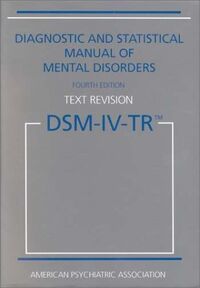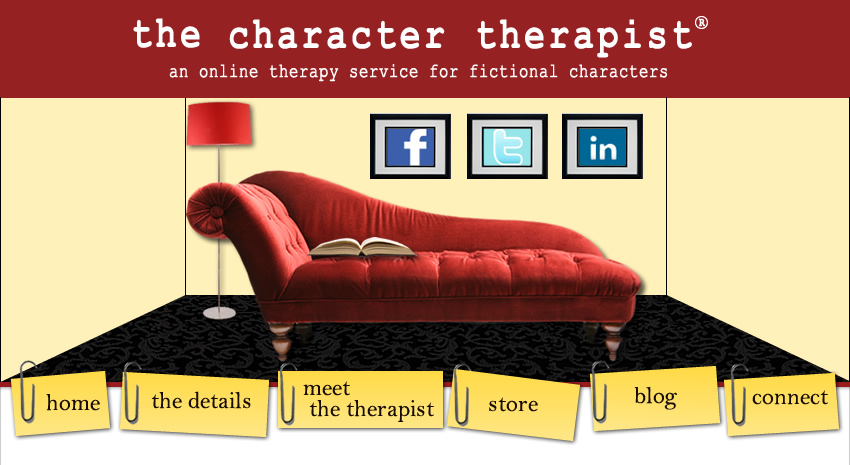 As promised, I want to wrap up our discussion on the Diagnostic and Statistical Manual of Mental Disorders (DSM). Last week, we talked about what kind of information you can glean from the DSM. You can read about that here.
As promised, I want to wrap up our discussion on the Diagnostic and Statistical Manual of Mental Disorders (DSM). Last week, we talked about what kind of information you can glean from the DSM. You can read about that here.This week, I want to explain what is called "multiaxial assessment." This is just a fancy way of saying that a clinician assess various fields (or axes) of information about a person. The DSM is set up in a multiaxial format, with the axes listed below:
Axis I - Clinical Disorders
Axis II - Personality Disorders/Mental Retardation
Axis III - General Medical Conditions
Axis IV - Psychosocial and Environment Problems
Axis V - Global Assessment of Functioning (GAF)
The various axes, or domains, provide a convenient way of organizing clinical information and capturing the complexity of problems that people may present in my office. I'll go through each axis and give more explanation. Be thinking about what type of multiaxial assessment your characters may have.

Axis I - Clinical Disorders
Clinical disorders are what we typically think about when we think of mental problems. Depression, anxiety, eating disorders, sleep disorders, OCD, impulse-control disorders, phobias, bipolar, schizophrenia, dissociative (multiple personalities), substance-related disorders, dementia, amnesia, reactive attachment, conduct disorder, oppositional defiant disorder, hypochondriasis, body dysmorphic disorder (Michael Jackson), sexual and gender identity disorders, etc. Just about everything in the DSM falls in this axis.
Usually whatever is coded on Axis I will be assumed to be the reason for the visit, unless it's noted that the reason for the visit is actually on Axis II.
Axis II - Personality Disorders/Mental Retardation
Personality disorders are much more pervasive, and encompass everything in a person's life, rather than just one aspect. For example, a person with generalized anxiety disorder might be able to have meaningful relationships, work productivity and socialization. But these aspects in a person's life may very well be a casualty of a personality disorder.

I'll give a listing of the personality disorders, but I won't go into detail in this post. (If there is one you are interested in, drop me a line.) They are: paranoid, schizoid, schizotypal, antisocial, borderline (Glenn Close in Fatal Attraction), histrionic, narcissistic, avoidant, dependent, obsessive-compulsive (the personality disorder is different from obsessive-compulsive disorder), and personality disorder not otherwise specified. Mental retardation is recorded on this axis, as well, because of it's far-reaching influence.
Axis III - General Medical Conditions
Sometimes, a medical condition can be relevant to understanding or managing an individual's mental disorder. Sometimes one causes the other. For example, if a person has a history of hypothyroidism (which presents as symptoms of depression), then you would record hypothyroidism on Axis III, and for Axis I, Mood Disorder Due to Hypothyroidism, With Depressive Symptoms. If a person has a malignant tumor, this could cause Major Depressive Disorder, Recurrent. Recording a person's relevant medical conditions is just good practice. It would be important for a hospital doctor to know that a diabetic is also a schizophrenic when dealing with an emergency room visit. It would be equally important for a therapist to know that someone they are seeing for an Anxiety Disorder also has asthma.
Axis IV - Psychosocial and Environmental Problems
This axis gives the clinician a succinct way of reporting a negative life event, a familial or relational distress, or a lack of environmental resources. There are 9 categories for convenience, and what each encomp
 asses (taken directly from the DSM). Think about your character's backstory when you look at this list.
asses (taken directly from the DSM). Think about your character's backstory when you look at this list.- Problems with primary support group - death of a family member; health problems in family; disruption of family by separation, divorce, or estrangement; removal from the home; remarriage of parent; sexual or physical abuse; parental overprotection; neglect of child; inadequate discipline; discord with siblings; birth of a sibling
- Problems related to the social environment - death or loss of a friend; inadequate social support; living alone; difficulty with acculturation; discrimination; adjustment to life-cycle transition (such a retirement)
- Educational problems - illiteracy; academic problems; discord with teachers or classmates; inadequate school environment
- Occupational problems - unemployment; threat of job loss; stressful work schedule; difficult work conditions; job dissatisfaction; job change; sidcord with boss or coworkers
- Housing problems - homelessness; inadequate housing; unsafe neighborhood; discord with neighbors or landlord
- Economic problems - extreme poverty; inadequate finances; insufficient welfare support
- Problems with access to health care services - inadequate health care services; transportation to health care facilities unavailable; inadequate health insurance
- Problems related to interaction with the legal system/crime - arrest; incarceration; litigation; victim of crime
- Other psychosocial and environmental problems - exposure to disasters, war, other hostilities; discord with nonfamily caregivers such as counselor, social worker, or physician; unavailability of social services agencies
Essentially, the clinician gives a "grade" on the client's overall level of functioning on a scale of 0-100. The clinician can track how well the client is doing based on this number as treatment progresses. There are 10 ranges of functioning within the 100 "points," each based on symptom severity (how much does the disorder effect the person) and functioning. In some cases, the severity of symptoms won't actually reflect the person's level of functioning. For example, a person who is a significant danger to themselves can live an absolutely normal, functioning life. But the GAF number would be below 20. The GAF always reflects the lower of the two components. There are different scales for adults and for children to make the process of selecting a number easier on the clinician.
So, an example of a multiaxial evaluation of someone who warrants information on all axes would look like this (just ignore the numbers):
Client: A.M.
Axis I 296.32 Major Depressive Disorder, Recurrent, Moderate (primary)
305.00 Alcohol Abuse (secondary)
Axis II 301.6 Dependent Personality Disorder
Axis III 278.00 Obesity
Axis IV Victim of child neglect
Axis V GAF = 35 (current)
Say this person came to see me and I requested records from a previous therapist and this landed on my desk. I'd already have a good idea of the client's background from the mention of being a victim of neglect. The obesity might well result in feelings of depression, which initiated the alcohol abuse, and addictions of any kind come easier for a person with dependent personality disorder. I just get a BIG picture snapshot of this person by utilizing this system.
Now there are those who don't like using numbers to define people. Let me say this: I'm a firm believer that no one is identified by their disorder. I don't like it when people are "labeled" or stereotyped by their disorder. Unfortunately, this happens a lot. Insurance companies demand a diagnosis, and if that diagnosis becomes public knowledge (say, the client slips up at tells someone at work), the client could end up the victim of social stigmas.
Still, the benefit of this type of "snapshot" of a person outweighs (in my opinion) the potential abuses of the system. What are your thoughts?
Q4U: What Axis IV problems do you have your hero or heroine dealing with?









2 comments:
Interesting! A topic that has recently caught my eye is arrested development, which fits in with your categories nicely. :O)
Hi, Jeannie!
This was so interesting! I found myself remembering an episode of "Law and Order: SVU" guest starring Cynthia Nixon. She played an character with multiple personalities.
Post a Comment
Both comments and questions are welcome. I hope you enjoyed your time on the couch today.